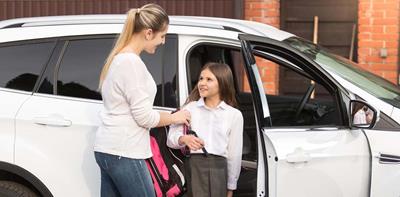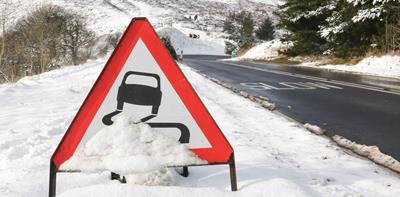
Driving in heavy rain on wet or even flooded road can be dangerous, so it's best to rearrange your travel plans if possible.
But if you can’t postpone your trip until conditions dry, here are some helpful tips for a safer, stress-free drive.
EASY AS HACK
When driving in heavy rain and floods, take your time and leave a safe braking distance – but forgo the fog lights.
At a glance
- Avoid driving in heavy rain and floods if you can.
- Don’t use your fog lights as they can increase glare and make it harder to see.
- Learn how to avoid aquaplaning on flooded roads.
How to prepare to drive in heavy rain
Here are some tips if you’re thinking about driving in heavy rain or floods:
- Decide if the journey is necessary or if you can delay it.
- Plan your route – choose roads that are less likely to flood.
- Check apps like Google Maps or Waze and local news channels to keep up to date with road closures
- Check your windscreen wipers and lights.
- Make sure your air conditioning and heating are working so it will stop your windscreen from fogging.
- Charge your mobile phone in advance if you need to call for help.
- Try to fill up with fuel beforehand.
- Check your tyres are the recommended legal tyre tread depth.
Tips for driving in heavy rain
When driving in the rain, you should take more care:
- Reduce your speed and take extra care when turning corners, especially if there’s standing water on the road, as you could risk aquaplaning.
- Leave more space than usual between your vehicle and the one in front. Did you know that, in wet weather, stopping distances are at least double those required on dry roads[1] Keeping your distance also helps to minimise spray from other vehicles hitting your windscreen and impairing your vision.
- Turn on your headlights so other drivers can see you more easily.
- Don’t use your fog lights – road safety organisations warn that fog lights can mask your brake lights and dazzle other drivers in rainy conditions.
- Avoid splashing pedestrians and cyclists. It’s not very considerate, and you can get landed with a fine.
- Disable cruise control so you can regulate your speed to suit conditions.
- Keep your air conditioning on to avoid fogging.
- Listen to local news for the latest on weather conditions.
What should you do if you break down in heavy rain
Pull over to a safe spot and turn on your hazard warning lights if you break down while driving in heavy rain or flooded roads. If it’s safe and possible, exit your vehicle on the side furthest from the traffic along with your passengers. Then contact a breakdown assistance service and wait for help.
Do not open the bonnet of your car, as this could cause further damage. For the same reason, if your engine cuts out in deep water, do not attempt to restart it.
How to drive on a flooded road
When driving in heavy rain, you should remember that it only takes two feet of water for some vehicles to start to float.[2] If water is building up on the road’s surface, consider whether you should drive through it. You could damage your car, as well as put yourself in danger.
- Size up the water first - If you suspect it is too deep, turn around and find another route.
- If the water doesn’t seem too deep, try to see if there are any objects that could damage your car’s wheels, tyres or suspension before driving through.
- Keep your vehicle in low gear and rev your engine, as this helps prevent water from entering the exhaust system and causing the engine to stall.
- If possible, drive in the middle of the road to avoid deeper water near the kerb.
- Don’t stop in standing water. If you think it’s shallow enough to drive through, wait for any vehicles coming the other way to pass.
- Press your brakes gently to test them once you’ve driven through the water. Doing this will also help them dry out.
How to avoid aquaplaning
When driving on a wet road, passing through puddles or flood water can cause aquaplaning, also known as hydroplaning.
Aquaplaning is when water gets between your tyres and the road surface, causing a loss of traction (or grip) that can make your car slide and make it difficult for the driver to steer or brake.
To minimise the risks of aquaplaning, ensure your tyres are in good condition (with the correct pressure and tread depth) and drive at a sensible speed. See our guide on what tyres do I need?
If your car starts aquaplaning:
- Take your foot off the accelerator.
- Hold the steering wheel straight and avoid making sharp turns, which can worsen the situation.
- Don’t brake until you feel the steering wheel respond again, then gently apply the brakes to slow down.
Can driving in heavy rain affect your car insurance?
Your insurance won’t be invalidated if your car is damaged when driving in heavy rain – but what is covered will depend on your level of cover.
Types of damage that an insurer may cover can include the one produced by:
- Flooding
- Hail
- Landslides and mudslides.
What won’t be covered:
- Damage resulting from reckless driving during heavy rain or driving without due care and attention that deliberately causes any loss or damage to your car. The damage includes purposely driving through flood water.
FAQs
Why is driving in heavy rain dangerous?
Driving in heavy rain and floods is dangerous because rain and spray from other cars can reduce visibility – plus, you need to factor in longer stopping distances.
Rain isn’t limited to the winter months, and cold weather can bring a whole host of challenges for your vehicle. Stay safe and prepared with our 10 tips to prepare your car for the cold weather.
How to brake in the rain
For safe breaking in rainy conditions, it’s best practice to slow down, brake early and gently, avoid sudden moves and leave extra space between you and the car ahead
How can you avoid problems with wet brakes?
Have your brakes properly maintained by a car mechanic and drive cautiously in wet conditions. If it’s safe to do so, dry your brakes after driving through water by gently touching your brake pedal to create friction and heat, causing water to evaporate.
What gear should you drive in the rain?
There is no specific gear recommended for rainy conditions, but you should drive in a lower gear and keep up your engine revs, especially if driving through floodwater or large puddles.
What is the braking distance in the rain?
The Highway Code says that stopping distances will be doubled in wet weather in comparison with dry weather.
How to drive up a steep hill in the rain
To drive up a steep hill in the rain, the safest approach is to drop into a low gear, maintain a slow and steady speed, and avoid sudden movements or hard braking.
Can you drive an electric car in the rain?
You can drive an electric car in the rain – manufacturers designed them to withstand wet weather conditions and pose no threat of electric shock, but, as with any vehicle, drive with caution.
How to drive at night in the rain
Driving in the rain at night presents challenges for even the most experienced drivers. Following a few key safety tips can significantly enhance your safety on the road:
- Ensure your windscreen wipers are working.
- Slow down.
- Increase your distance between cars.
- Use dipped headlights.
- Use your heating/air conditioning to prevent the windscreen from fogging up.
- Avoid standing water.
Does insurance cover hydroplaning accidents?
Car insurance covers hydroplaning accidents if the accident has not occurred due to reckless driving.
Will I be covered if I drive through a flooded road against advice?
If you drive through a flooded road against advice, that could be classed as reckless driving, and as a result, your insurer could deny the claim.
Will my insurance be invalidated if I drive during a red weather warning?
Typically, insurers do not invalidate insurance if you drive during a red weather warning because red weather warnings advise you to avoid travel wherever possible, but they don’t prohibit driving.
It’s illegal to drive a car without insurance, but it’s also reassuring to know you can get damage caused by driving in the rain repaired – if you have the right policy. Find out more about our car insurance.
Sources
[2] www.brake.org.uk


